How to Use Google Trends for Keyword Research: 7 Effective Ways
That is why we decided to write an article about Google Trends.
In this post, we’ll cover a few cool ways to use Google Trends to help with your keyword research and content marketing strategy.
But first, let’s get to the bottom of what Google Trends is (and isn’t).
Here’s everything you need to know about Google Trends data (and how it works)…
When I started writing this article, I realized there is some confusion about Google Trends data across the internet.
Many people think that the trend curve is the direct representation of the query’s search volume over time (like the one you can see in the Google Keyword Planner tool).
That’s not exactly how it works.
Let me show you the trends graphs for the keyword “flowers” in Google Trends and the GKP tool:

You can no longer see such graphs in Google Keyword Planner unless you’re spending a certain amount on AdWords ads.
As you can see, they look quite similar, but they’re not identical.
While Google Keyword Planner shows absolute search volume data, Google Trends shows the relative popularity of a search query.
Here’s the explanation from Google Trends Help Center:
Trends adjusts search data to make comparisons between terms easier. Each data point is divided by the total searches of the geography and time range it represents, to compare relative popularity.
In other words, relative popularity is the ratio of a query’s search volume to the sum of the search volumes of all possible queries.
The resulting numbers then get scaled on a range of 0 to 100 based on a topics proportion to all searches.
Trends eliminate repeated searches from the same person over a short period to give you a better picture. And it is important to note that Trends only shows data for popular terms (low volume appears as 0).
Here’s the Google Trends graph for the query “Facebook” over the past 12 months (in the US):
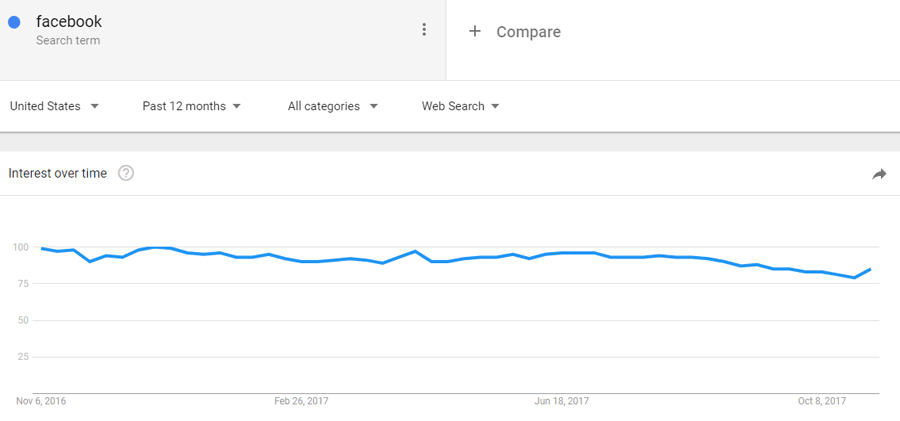
To demonstrate to you how Google Trends builds its “Interest over time” graph, let’s pretend I have the same data Google has. (I don’t really have it, unfortunately.)
The numbers I will use below are by no means accurate. They are just an assumption to demonstrate how things work.
Assumption 1: the total monthly number of all Google searches in the US is around 10 Billion (Source)
Assumption 2: the search volume for the query “Facebook” in the US is 83 Million (according to Ahrefs Keywords Explorer)
Here’s the table I made for this simulation:

To build a graph the way Google Trends does, you need to take the following steps:
- Calculate relative popularity as a ratio of the query’s search volume to the total number of searches.
- Scale these values proportionally so that the maximum value is 100.
- Put the dots on the graph.
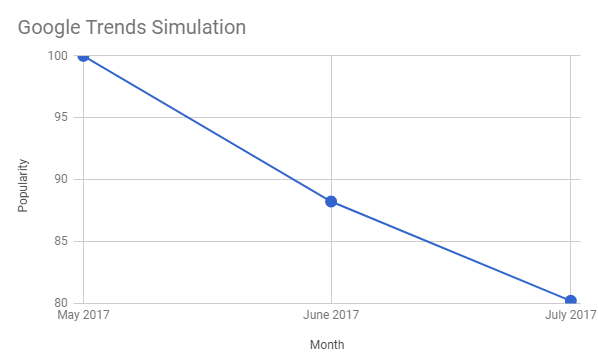
This example gives us two important takeaways:
- Search term popularity changes when the query’s search volume changes (see May 2017 — June 2017). That’s pretty obvious, right?
- Search term popularity will also change if the total number of searches changes, even if the query’s search volume is constant (see June 2017 — July 2017 in my example above).
Now you see that popularity used in Google Trends does not always correlate with query search volume. But in most cases, it does.
For example, if you take the keyword “Star Wars,” you’ll notice that the same spike (December 2015) appears in Google Trends and Ahrefs Keywords Explorer.

This is despite the fact that Keywords Explorer shows the search volume trend, whereas Google Trends shows the “popularity” trend (as outlined above).
Now let me show you how you can (and should) use Google Trends in your online marketing activities and during keyword research in particular.
Prefer video? Watch this.
Otherwise, read on.
1. Identify seasonal trends, then create (and promote) content at the RIGHT time!
You probably realize that search volumes for some keywords are affected by seasonality.
For example, take a look at the Google Trends data for the keyword “umbrella” in the US.

And here’s the same trend in Australia:

You can see that the query “umbrella” is the most popular in the US in June while in Australia the peak falls in December. These are the months when the rainy season begins in these countries, and people realize they don’t want to get wet.
So if your business is season-dependent, you can quickly estimate its peaks and bottoms by analyzing the relevant search queries in Google Trends.
You can then put this data to use in two ways:
- Create relevant content to coincide with the peak: For example, if you live in Australia and sell umbrellas, it may make sense to put together a “wet season preparation guide” and publish it in December. After all, this is when your potential customers are most likely to be searching for such information.
- Start optimizing existing relevant pages before the peak(s): Let’s say you already have a “wet season preparation guide” or perhaps even an e-commerce page selling umbrellas. It would make sense to start prioritizing the optimization of such pages a couple of months before the peak occurs (i.e., 2–3 months before December, if you’re in Australia). For example, you could start a link-building campaign in October—this will likely result in a small rankings boost in time for the peak search period.
2. AVOID “keyword unicorns” by checking for data-skewing popularity spikes
If you’re trying to pinpoint a good topic for your next content piece, don’t write a single word until you’ve checked said topic with Google Trends.
You don’t want to waste time creating content for falling topics.
For example, according to Ahrefs’ Keywords Explorer, the term “fidget spinner” has an average monthly search volume of 900K+.
But the term “yoyo” only averages 47K searches per month.

Given that the Keyword Difficulty (KD) for both of these keywords is similar, it would much more sense to create content around the term “fidget spinner,” right?
NOPE.
Here’s a comparison of both terms in Google Trends.
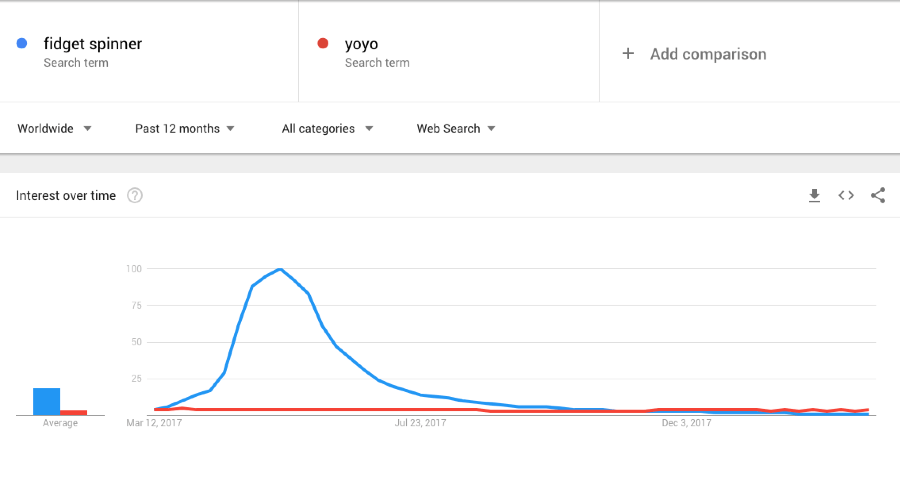
You can see that there was a massive spike in the popularity of “fidget spinner” in May 2017.
But since then, interest has dropped off massively—it’s now almost nothing.
On the other hand, interest in yoyos (I love yoyos) remains steady.
In fact, if you look closely, you’ll see that “yoyo” is now a more popular term than “fidget spinner.”
3. Find relevant topics that are trending RIGHT NOW…then capitalize on them
Using Trending Searches, you can find search queries that have seen significant jumps in popularity over the past 24 hours (in any given location).
But why would you want to do this?
Well, let’s assume that you run a blog about celebrities.
You check Trending Searches on March 4th, 2018 and see this:

It looks like the Oscars are trending!
But doesn’t the fact that this topic is trending means that you’re too late already?
Not necessarily.
Here’s the search trends graph for the phrase “Oscars” over seven days from March 2nd — March 9th:
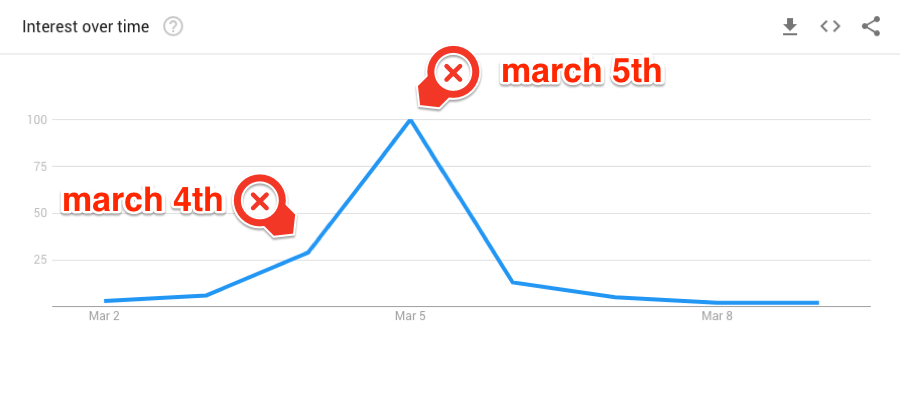
You can see that March 4th—the day the topic was trending in Google Trends—wasn’t actually the peak; March 5th was the peak.
It then dropped off on March 6th.
So while the window of opportunity here may be small, you can see that there still is an opportunity.
This isn’t always the case, though.
Sometimes Google Trends does highlight the trending topic on the day it peaks.
For example, the term “Mother’s Day” didn’t become a trending search until March 11th.

But because March 11th was Mother’s Day (at least in the UK), interest immediately dropped the following day.

In this instance, unless you already had Mother’s Day-related content prepared in advance, you would have been too late.
But how do you figure out whether or not a trending term has already peaked?
Well, if it’s a term that likely spikes at the same time every year, take a look at when the peak occurred last year.
For example, Mother’s Day fell on March 23rd, 2017. Once again, this is when the peak occurred.
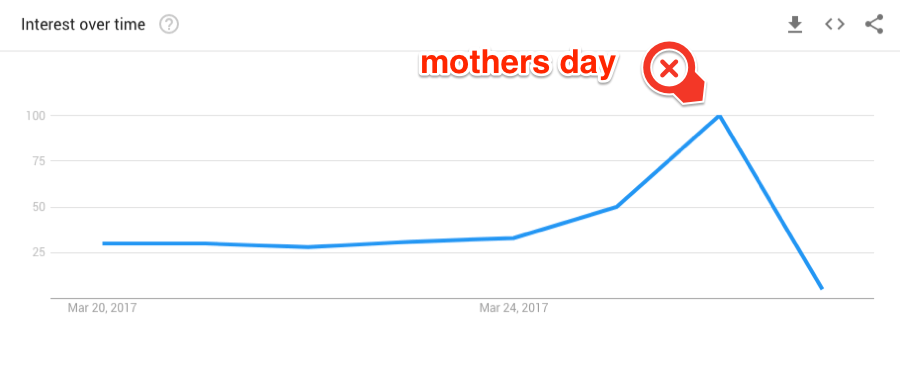
By looking at this historical data, you can predict whether interest in a trending topic is likely to rise or fall.
4. Use Google Trends data to help plan your content calendar
Wait a minute!
Let’s take a closer look at the Google Trends data for the term, “Oscars.”
If we look at the term over a 5-year period, we can see that the peak occurs at roughly the same time each year; the beginning of March.
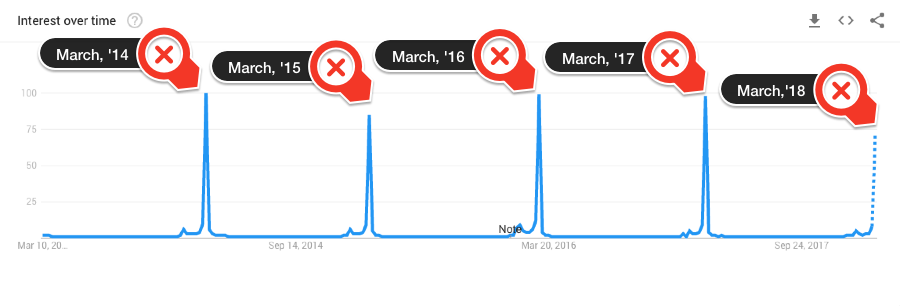
This is because the Oscars take place each year in March.
So if you run a website about celebrity gossip, you should probably make a note of this in your content calendar.
You can then make sure to produce content on this topic in March every year.
(I know what you’re thinking…this is a pretty obvious example, right? I mean, if you’re running a celebrity gossip website, you’ve most likely got this covered already.)
Here’s a less obvious example:

Here, you can see a peak occurring roughly once per month.
Can you guess what search term this is?
“Full moon.”
But how would you adjust your content calendar to account for this? Surely it wouldn’t make much sense to publish a new post about full moons every month, right?
Very true, but you could create ONE post and then update it with fresh information each month. 🙂
This is what Space.com do with their full moon calendar.
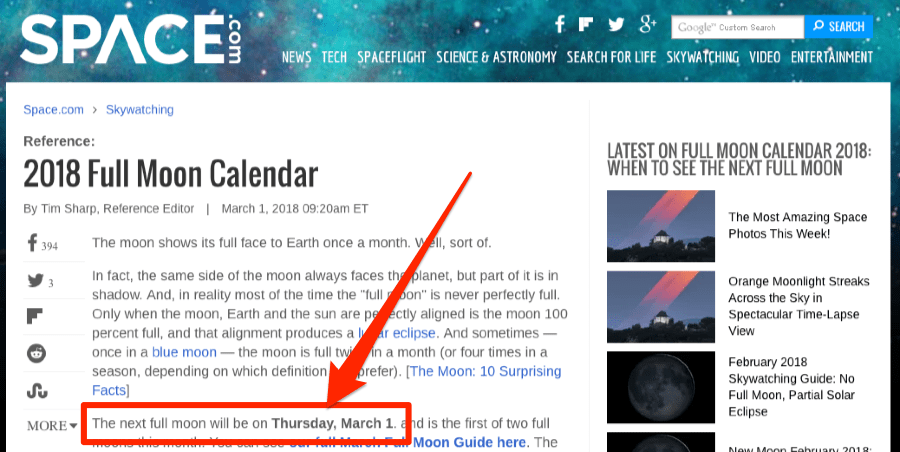
All they have to do is update a few facts and figures each month.
It likely doesn’t take much effort, but it keeps the content fresh and up-to-date.
Want to see an even less obvious example? Check the Google Trends data for “scary outfit.”

There’s a spike in search popularity every year around October—i.e., Halloween.
What’s my recommendation for this one?
Publish the “top XX scariest Halloween outfits for 20XX” every year in mid-October. (Or update your existing post from the previous year.)
Simple, but effective. 🙂
Google Trends can reveal the queries people also search for when they search for your term.
For example, people searching for “sneakers” also tend to search for “Nike” and “Adidas.”
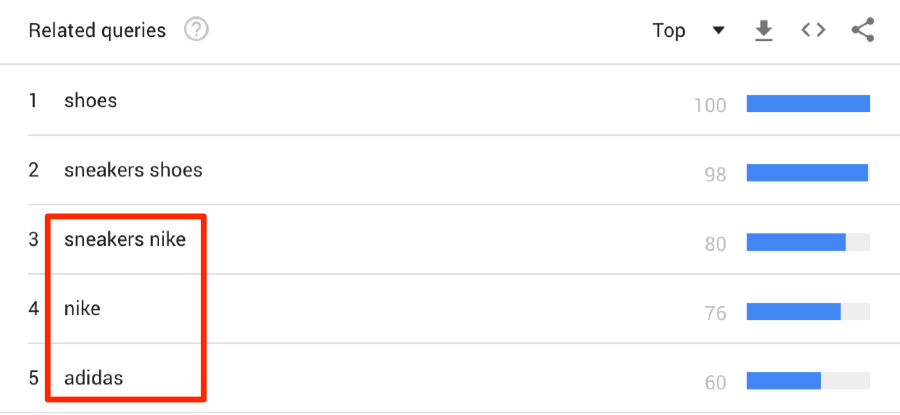
There are two options available in Google Trends for related queries: “Top” and “Rising.” If you’re curious as to the differences between these two options, hit the question mark icon next to “Related queries” in the Google Trends interface (hint: take a look at the screenshot above to see where this is).
Not only does this provide a great opportunity to find more keywords (i.e., those you might not have already thought of), but it also helps you to better understand the needs of your potential customer and their “search journey.”
But you can also go one step further by finding the related searches for the related searches.
For example, here are the related searches for “sneakers Nike” (i.e., one of the related searches from our previous search).

But don’t stop there.
You can also take the queries suggested by Google Trends and use them as seed keywords in Keywords Explorer. This will give you even more keyword ideas.
There you can apply search filters for Search Volume and Keyword Difficulty (KD) to find some real gems.
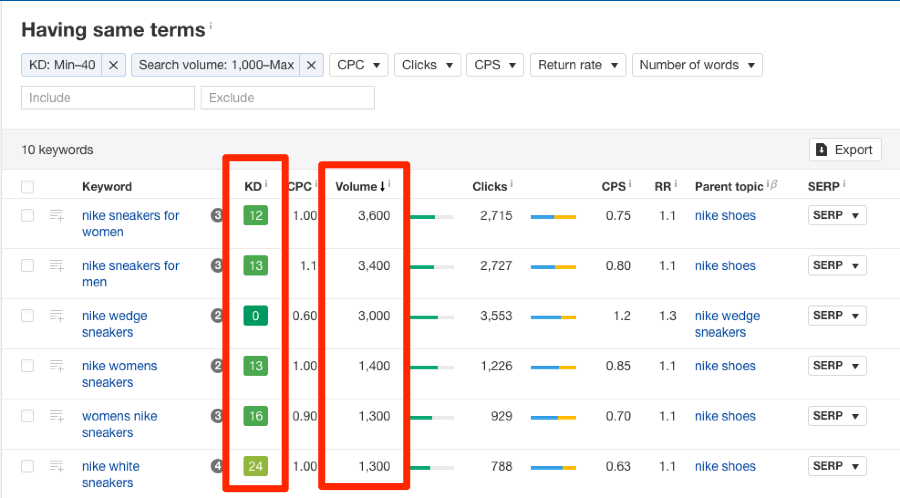
People are likely Googling your brand.
But which of your competitors are they also searching for?
Here’s how to find out:
Enter your brand name into Google Trends, then take a look at the related queries.
Here are the related queries for the term “Ahrefs”.

It looks like people are also searching for three of our competitors.
These people are most likely potential Ahrefs customers who are still researching their options.
It would, therefore, likely make a lot of sense to educate these people by showing how Ahrefs favorably compares to the competition.
We could do this by creating some “Ahrefs vs. competitor” type posts (e.g., “Ahrefs vs. Moz”).
In fact, we plan to create such pages in the future. We’re just busy with other, more important things at the moment.
Here’s an example of such a page from Asana.

6. See EXACTLY which cities and subregions NEED your products or services (then get laser-targeted with your SEO strategy)
Google Trends lets you see where (i.e., country, city, subregion, or metro) a search query is most popular.
This can answer a fundamental question: where are your products or services needed most?
Let’s see where in the US space heaters are widely sought after.
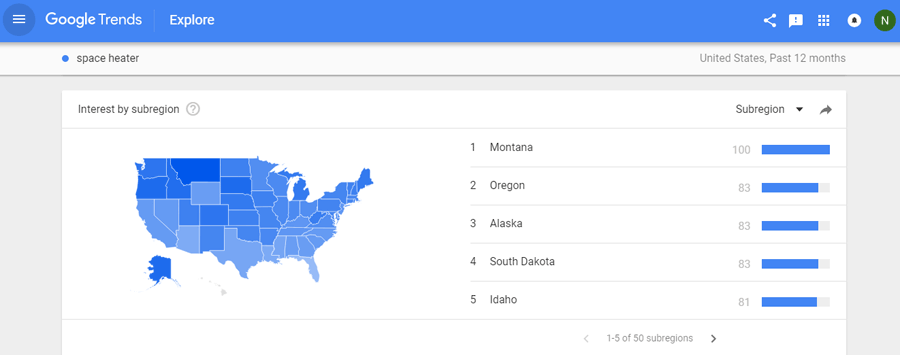
Northern states. Which is quite obvious.
How about a city-level breakdown? Google Trends can do that.
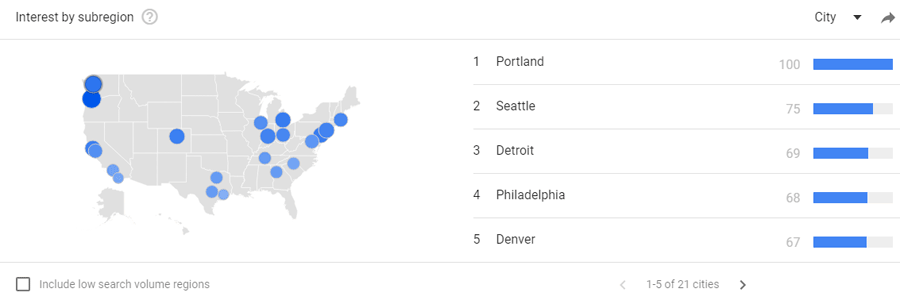
(Anyone from Portland? What’s the weather like?)
But how can you use this data?
Here are just a couple of ideas:
- Target these regions with PPC (i.e., AdWords) — Don’t waste money targeting the whole of the US on Google AdWords. Just run ads for the cities or subregions where your potential customers reside.
- Create useful content that’s specifically aimed at people in these areas — E.g., “Living in Seattle? Here’s how to save money on your heating bill this winter”.
Google Trends also lets you compare how interest for a particular search query differs in multiple locations. (To my shame, I discovered this feature just a few days ago.)
To do that, click “more” on the right-hand side of one of the search boxes and apply relevant filters:

In the screenshot below, you can see a perfect example of the “popularity” concept in Google Trends:

The search volume of the “Star Wars” query is obviously way higher in the US than in the UK. But the graphs are almost identical. This means that Star Wars is equally popular in both regions.

Imagine that you’re a Florida-based accountant.
How do you know where your services are needed most?
Simple. Search for “accountant” in Google Trends, filter by state, then check out the “interest by metro” breakdown.
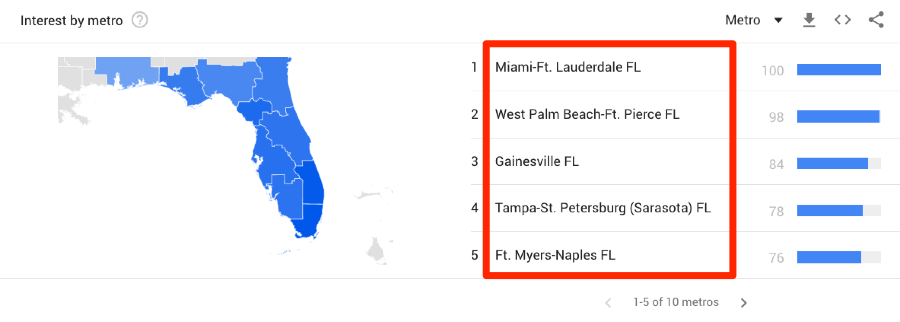
(You can also look at “interest by city” for a more granular view.)
Now that you know where your services are most needed, you can use this data to prioritize your local SEO efforts. E.g., you might decide to create landing pages targeted explicitly at Miami or Gainesville residents.
You could even use this data to make expansion plans for your business—it is that powerful.
7. Refine your video SEO strategy by analyzing WHAT people are searching for on YouTube
Google owns YouTube, but that doesn’t mean the popularity of a particular search query is equal across both search engines. It isn’t.
To illustrate this, here’s the Google Trends web search data for “HTML tutorial” since 2008.

You can see quite clearly that the popularity of this term has been falling quite consistently.
But here’s the trends graph for YouTube.
(Yes, Google Trends lets you filter for YouTube trends—just hit “YouTube search” on the drop-down)
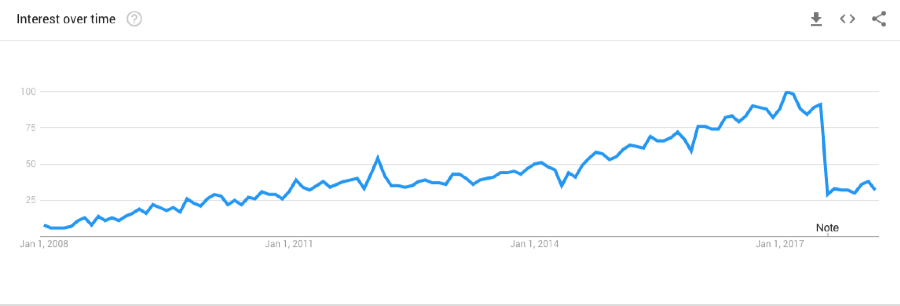
Interestingly, we find the opposite—popularity on YouTube is rising.
It looks like people are increasingly turning to YouTube for their HTML tutorial needs.
So it would be well worth creating a YouTube video to try to rank for this term.
It makes total sense that people would be searching for terms like “HTML tutorial” on YouTube over Google.
But in some cases, you might question the validity of this data.
To double-check that people do indeed seem to prefer videos over written content, enter your query into Ahrefs’ Keywords Explorer. Then check the SERP overview.
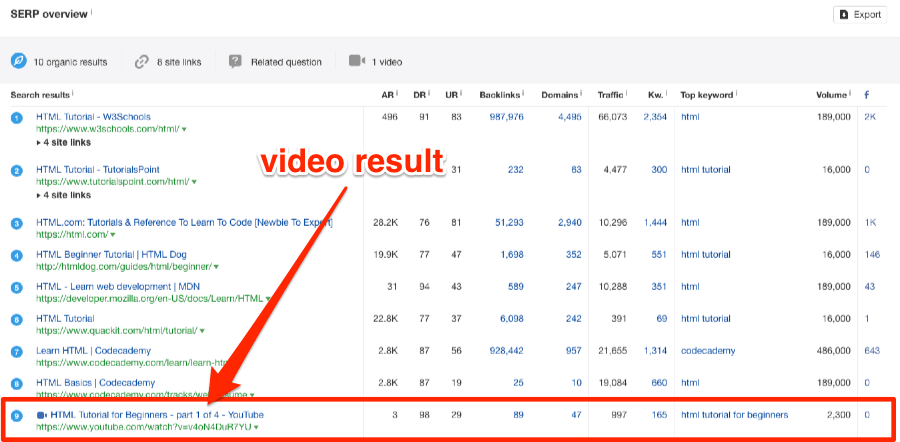
If you see any video results ranking on Google, chances are Google has identified that searchers want to view video content on this topic.
So you can be sure that there’s a decent search volume on YouTube for this query.
Final Words
Google Trends was not specifically made for content marketers and SEOs. But as you can see, it can be very useful for keyword research. (And other marketing-related tasks.)
There’s no other tool that will give you the freshest data on what’s trending in search right now.
Do you use Google Trends in your marketing work? I’m looking forward to learning your tips and tricks.
This article was first published here.


Comments are closed.